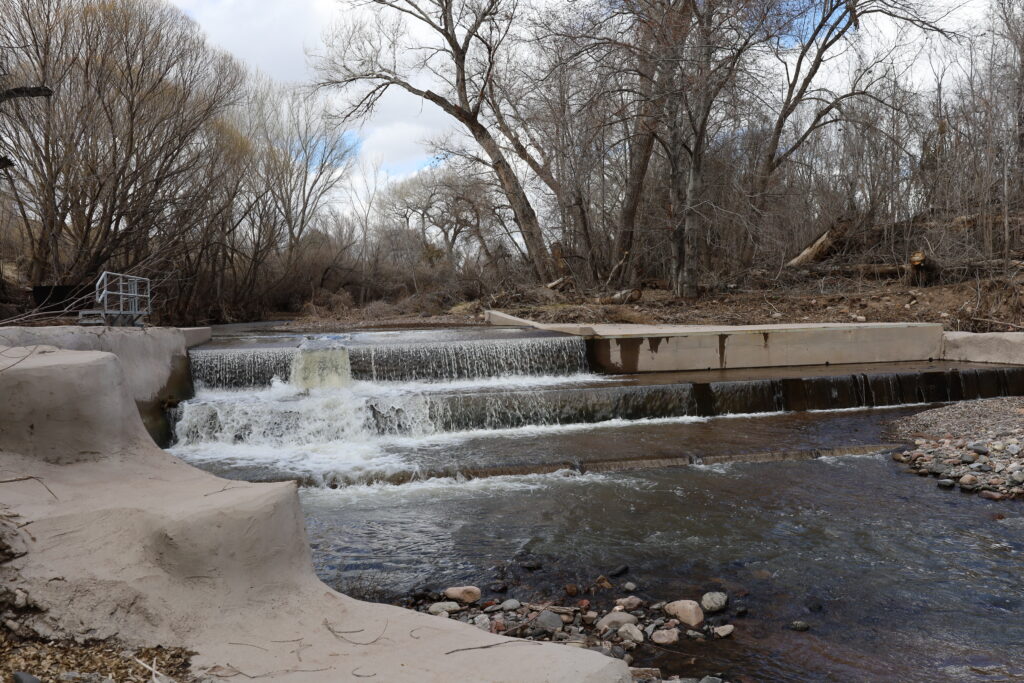
A diversion on the Mimbres River in southern New Mexico in February 2023. (Photo by Megan Gleason / Source NM)
After unprecedented disasters, local governments in charge of centuries-old community ditches in New Mexico are asking state lawmakers for tens of millions of dollars more than usual to maintain and rebuild acequias.
The New Mexico Acequia Commission and the New Mexico Acequia Association outlined their joint legislative priorities for the upcoming session last week.
There are more than 700 acequias across New Mexico, and these irrigation ditches support communities and families rooted in the practice. Some of the ditches are decades, if not hundreds of years old, and the practices are ancient – as Pueblo peoples used irrigation methods before Spanish colonization. Acequias are often loosely and locally governed, often by volunteers.
But a rapidly changing climate making water more scarce and disasters like fires and flood increasingly devastating is putting the traditional practices at risk.
Lawmakers in 2003 empowered acequias to approve or deny water transfers without having to go through state officials first, and in 2019 set aside $2.5 million per year to build and maintain irrigation infrastructure.
However, that is not enough, acequia advocates say. According to a rough estimate, in the coming decades, acequias will need about $68 million to maintain or improve their irrigation infrastructure, said Paula Garcia, the executive director for the grassroots Acequia Association.
“We don’t have complete data on all the infrastructure needs across the state but with that snapshot, I’m confident the need is in the tens of millions every year,” she said.
There is no one state agency devoted to acequias, instead, there’s responsibility held across multiple state departments – including the New Mexico Office of the State Engineer or the New Department of Agriculture.
Acequias will likely face challenges in getting the funding they need from the Legislature’s budget hawk, Sen. George Muñoz, who chairs the powerful Senate Finance Committee. In September, as state agencies were preparing their budget requests for next year, he called for “a disciplined approach” to spending public money.
Cost sharing for infrastructure, disaster assistance
The acequias are urging lawmakers to give $10 million to the Interstate Stream Commission to help pay for infrastructure repairs, which require local governments to pay a 25% cost-share, Garcia said. Acequias need the state to step in because they do not have the power to tax.
Acequias’ inability to pay for debris removal has become more urgent since 2022, and resulted in “astonishing” delays in rebuilding acequias destroyed by wildfires, Garcia said. She called for debris removal after flooding to be more institutionalized and not just a reaction to emergencies.
For example, Garcia’s own acequia in Mora County is in its third year without water and won’t be rebuilt until 2026.
“It seems like every time we have a disaster, we’re reinventing the wheel,” Garcia said. “It’s not good for our state.”

After the Hermits Peak-Calf Canyon fire, the state Department of Transportation quickly hired contractors to remove debris, Garcia. But the debris removal process is uncertain, she said, and not easy to stand up in real time when disaster strikes.
“Unless we figure this out as a state, there are going to be communities that are left behind because they can’t do that cost-share,” Garcia said.
Acequias are supporting the Interstate Stream Commission’s request to double the Acequia and Community Ditch Infrastructure Fund from $2.5 million per year to $5 million. The fund is used to pay for planning, designing and building irrigation systems or matching funds for other state and federal programs.
The current $2.5 million alloted is only meeting about half of the requests coming through the program, Garcia said.
While there are state funds for tribal infrastructure and colonias, there is no comparable fund for acequias, said Rep. Susan Herrera (D-Embudo).
These water systems which allow small farming and ranching operations to exist almost entirely rely on volunteers, and they can’t be maintained or fixed using only one-time money, Herrera said. Those volunteers are also getting older and the number of people who can work on a ditch is getting smaller, she said.
“I’ve told my volunteers: if you want to shut down the state, everybody can go on strike in the north and not do water systems for a year. See what happens,” Herrera said.
Settling water rights disputes
The acequias are supporting the New Mexico Department of Agriculture’s request to increase its Acequia and Community Ditch Fund from about $830,000 per year to $1.5 million.
The fund is used to pay for attorneys and experts in determining who has the right to what water. There were a total of $1.3 million in requests for help in the previous fiscal year, according to the acequias’ presentation.
The acequias are also supporting the State Engineer’s $40 million request to help pay costs resulting from court settlements over water rights, which finalize the oldest water rights in the state held by the Pueblos and also acequias’ water rights, Garcia said.
Water rights agreements between sovereign nations and American governments must be approved by Congress.
Congress has approved final settlements in four separate cases involving Native nations in New Mexico, and there are still four where Congressional approval is pending but federal legislation has been introduced, according to the acequias’ presentation.
Other acequia priorities
- Amend the Community Governance Attorney Act so the state Department of Justice and acequia-serving nonprofits can hire attorneys specializing in land grants, acequias and colonias.
- Boost funding for community and youth education programming about acequias from $492,000 to $750,000, and codify it into state law.
- Increase the Acequia Commission’s annual budget from $88,000 per year to $160,000, which would allow them to hire a full-time worker.
- Set aside $500,000 for the State Auditor’s Office so they can hire accountants to help acequias audit their finances, rather than requiring the acequias to hire the accountants themselves.

